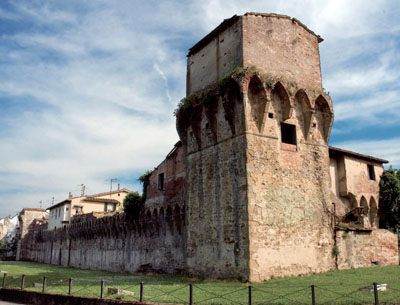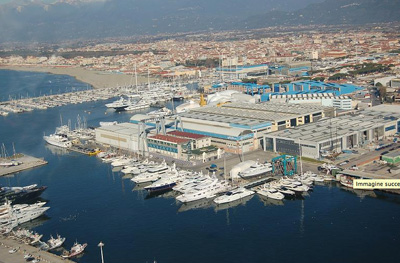
Lastra a Signa
Old and ancient, Lastra a Signa in Tuscany derives its name from the Lastra dei Gangalandi family who held the fiefdom. But its history goes back to the year 1000 when the Cadolingi di Fucecchio lords held Lastra a Signa under their rule. Lastra a Signa is positioned at a strategic point right in the middle of the Arno Valley. Having access to the sea, Lastra became a focal port for Florence and Pisa. The city center stands on the foundations of the fortifications built on Mount Cascioli and Mount Orlando. Lastra defended itself against continuous sieges against Florence and Pisa. In 1377, the town of Lastra was encircled with town walls and a crenallated tower.
Enclosed by its medieval walls and the gates of Pisane and Bacchio, the Saint Mary Church built in 1404 is in the middle of Lastra. The lovely works of art are still preserved in the church displaying a painting by Francesco Conti named “Saint Rocco in Glory” and another painting portraying “Our Lady”, that dates back to the 14th century. You can also find a memorable work that portrays Podestà’s Tabernacle with a fresco dating back to the 16th century with “Our Lady with the Child between the Saints John Baptist and Francis”. The Praetorian Palace in Lastra a Signa still has the emblems of the Podestàs on the walls. The breathtaking Villa di Bellosguardo or the villa with a beautiful view in Lastra was owned by the famous tenor Enrico Caruso. The lovely Renaissance Villa Bellosguardo was earlier owned by the Marquises Pucci and was renowned for its fabulous architecture. As you enter its elegant doorway, you will find beautiful rooms with soaring vaulted ceilings, grand staircases, frescoed friezes and deep pink velvet upholstered furniture. Ornate in structure with rich and varied architecture, the gorgeous Ballroom leads to the refreshing Orangerie that is striking with fantastic views. Historical and artistic, Lastra a Signa is famous for its ancient churches, villas and country homes of the nobles of the Middle Ages and a retreat of the rich and the famous through the Renaissance period.
Lastra a Signa opens out her beautiful countryside with the stunning colors of Tuscany. As the eye traverses the rich scenery, the famous Villa Pandolfini comes into view with its lush private forests. This beautiful castle dates back to the 1200s and was built by the Medicis for their family and friends who loved to hunt. Later, the Pandolfini family owned this lovely villa and also another historical one called ‘Le Torre’ that was a walled castle from the 1300s. Agnolo di Filippo, who was a great friend of Cosimo de Medici, lived at Villa Pandolfini for 12 years. It was here that he wrote his historical dialogues on the governing of the family. He died in 1446 at the age of 86. In 1434, Filippo’s nephew renovated the villa with fabulous architecture with the date, 1488, engraved on its wall that portrays the time of the completion of the renovation.
Created with stunning architecture with a linear concept, the harmony and space have been balanced to please the eye and deliver an aesthetic sense. The famous architect, Benedetto da Rovezzano executed the renovation with a keen eye for detail displaying beautiful carved windows, a lovely loggia, excellent stonework and free flowing lines. The Villa has been host to several personalities including Napoleon, King Carlo VIII of France and King Charles VIII of France.
The early 1800s saw the Pandolfini family selling their antique villa to the Samminiatelli family. They in turn sold the villa to the De Prat family who had returned after their exile from France following the Revolution. The estate ranges over a huge area of private forests, vineyards and olive groves. Tranquil, stunning and spacious, the villa is just 10 minutes away from Florence. The Villa showcases antiques, frescoed ceilings, a lovely loggia and an amazing Renaissance garden. With elegance and an air of mystery surrounding the Villa, inviting paths lead to beautiful walks, an outdoor dining area and a tranquil ambience. The Villa Pandolfini is vantage starting point for great excursions into the heart of Tuscany. The estate produces extra virgin olive oil and typical Chianti wine under detailed and careful supervision.
The Villa Pandolfini basks under the Tuscan sun and is adorned with frescoes, mirrors with gold gilt, terracotta floors and elegant columns carved in stone. Decorated beautifully, the rooms are bedecked with silk curtains, ornate fireplaces and a beautiful antique crystal chandelier. The Villa was originally built as a hunting lodge for nobles of bygone days and is a fabulous retreat just a few miles from Florence. The gallery kitchen is a work of wonder with its enormous fireplace and an old marble sink. The Villa Pandolfini is a work of art, a picturesque getaway and enhances lifestyles with a rich and royal air.
Web site: www.comune.lastra-a-signa.fi.it




